While watching a solitary bee feeding on nectar in basil flowers in the herb patch a few weeks ago, I noticed a minute spiny flower mantid nestled down on one of the flower spikes with its spiny abdomen curled up over its back.
Over the next few days we spotted a total of six tiny spiny flower mantids (Pseudocreobotra wahlbergi) on the perennial basil bush (Ocimum basilicum sp.) and later we found one on flowers of a purple broom (Polygala virgata), which is pictured above, and then another on a rosette of leaves of a Solanum giganteum, even though the plant has finished flowering.
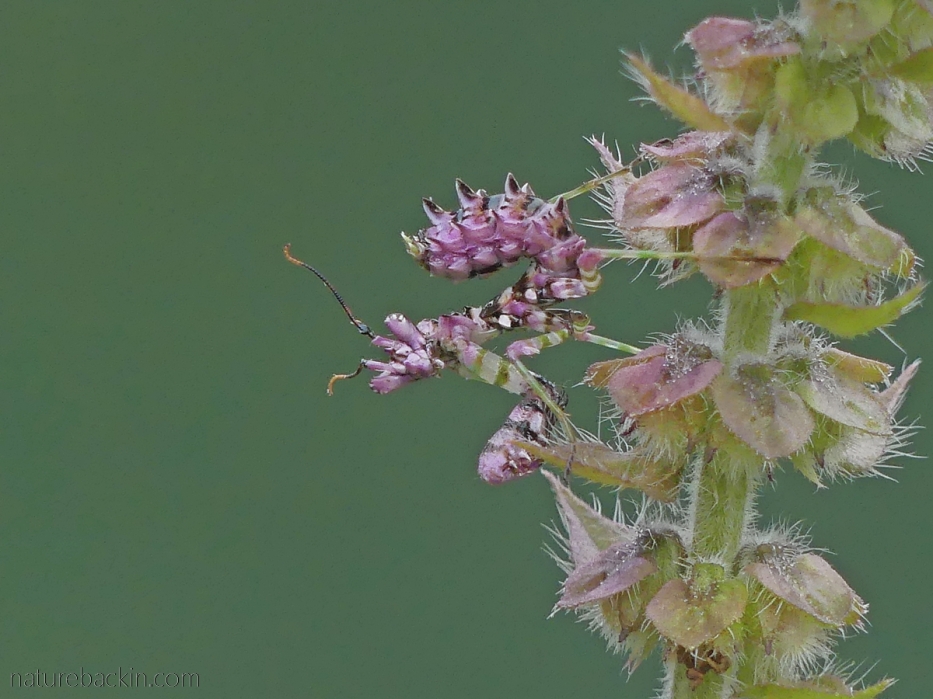
Above is one of the spiny flower mantid nymphs on the basil bush. The younger they are it seems more green bands are visible on the legs. As they get older they better blend in with the pinkish colours of the bracts on the basil bush’s flower spikes.

Above is an even tinier spiny flower mantid nymph showing the greener colour variation. The nymphs go through several moults to reach adulthood – seven for the females and six for males.

In order to try to show in a photograph the tiny size of the spiny flower mantid nymphs, I held a standard-size matchbox on a stick behind one of them so that the comparative size can be seen. I was most surprised when the mantid climbed onto the box! Once I had taken the photograph I moved the box towards a flower stem and it climbed back onto the flowers, seemingly unperturbed by the photo shoot.
Black circular marks can be seen on the back of the head behind the eyes and just below where the antennae sprout from the top of the head. The mantid in this photo is looking down and so its wedge-shaped face is hidden from view.
With the camera I currently have it is particularly challenging to photograph these creature – firstly, because they are so tiny, and secondly because they are so well camouflaged. Difficulties with the light (too bright or too dark) and breezes rocking the plants added to complexities.
I use a bridge camera and its macro functionality is not really good enough, and standing back and zooming-in is also unsatisfactory. I fiddled with editing photos quite a bit to try to make it possible for these exquisite creatures to be better discerned from the background.

I even resorted to isolating the creatures from the rest of the photograph to try to make them clearer to see. Interestingly, whenever I get close to them, they tuck their antennae back and flatten them down, which they also seem to do when in ambush hunting mode. Once I move away they are confident enough to erect their antennae again, while they are obviously watching me.
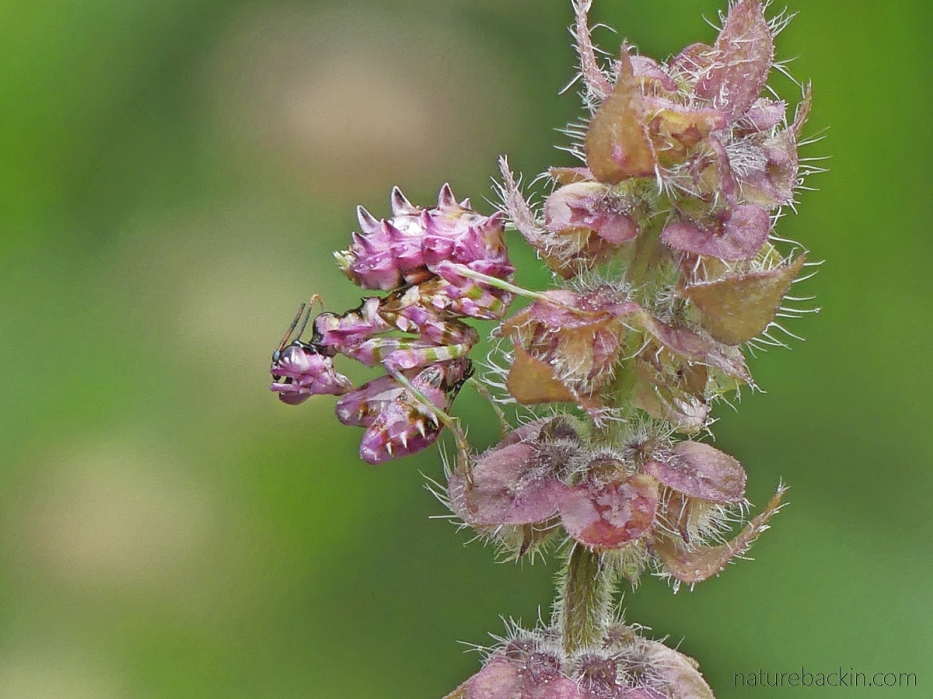
One of the spiny flower mantid nymphs in typical hunting posture – facing down with antennae folded back. It can clearly be seen in this photo how the very long forelegs are folded double. These legs extend incredibly far and incredibly quickly when the mantid reaches out suddenly to grab prey. The spiny abdomen is folded up over the back, concealing the eye spot that develops on the nymph at each stage (instar) of development after the exoskeleton is shed.

So far I have been lucky enough only once to see one of the mantid nymphs shedding its exoskeleton. By the time I saw it, the process was nearly completed. In the photo above, the nymph is hanging down upside down with the exoskeleton somewhat crumpled adhering to the underside of a leaf. The abdomen is elongated and what looks like the beginnings of an eyespot can be seen on the upper-side of the abdomen. I assume that the wings are starting to develop although I cannot see them at this stage. The two black spots behind the eyes are visible as the head is tucked down towards the forelegs.

Watching solitary bees and other insects visiting the basil flowers is somewhat nerve-wracking with the mantids in residence. As they get bigger the mantids are tackling larger prey, but in this photo the relatively robust carpenter bee was ignored by the mantis that can be seen facing away from the bee on the other side of the flower stem and further up from where the bee is hovering.
At one stage I did see a very small mantid eating a largish ant, but mostly they ignore ants that visit the flowers around them. But on one occasion we watched a mantid actively avoiding a specific (rather small) ant and even jumping onto another flower stem to get away from it.
The mantids are very good at climbing – extending their forelegs to help them move along at a surprising speed. Late one afternoon I was aware of a katydid in the basil bush but on a different stem and some distance away from the closest mantid. Suddenly the mantid started moving fast, I got distracted but then saw it had jumped onto the same stem as the katydid and suddenly there was a struggle. At first I was not sure who had captured whom, and then it became apparent that the struggling katydid was the victim.

This was the best photo I managed to get of the mantid clutching and eating the unfortunate katydid, which was still struggling and kicking its hind legs as the mantid proceeded to make an incision and commence sucking out its bodily juices while the katydid was still alive.
I was surprised at how actively the mantid hunted its prey as I have read that mostly they sit in one place ambush hunting by grabbing anything that passes or lands nearby .
Early one evening I came across one of the mantids eating a fly it had caught, but the light was so low that the photos I took are not really worth sharing.
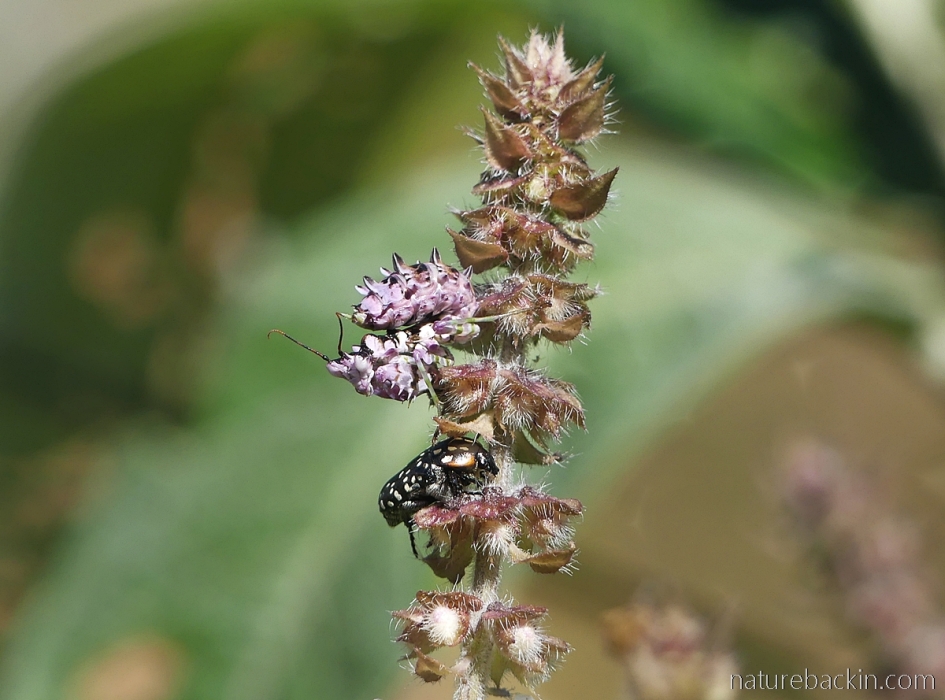
As can be seen in the photo above the mantids cohabit with common dotted fruit chafer beetles that visit the basil bush, even in close proximity. By the way, we cohabit with chafer beetles in our garden too. They mostly seem to eat pollen and I have not noticed them causing any significant damage to any plants.

An identified bee spent a lot of time sunning itself in the early morning at the top of a basil flower spike and it was completely ignored by the spiny flower mantid, which is well camouflaged and quite hard to see on the flower stem below the bee.

The unidentified solitary bee in the above photo flitted from flower to flower, pausing to take in nectar and it was also ignored by the mantids. In this photo a mantid can be seen towards the top right in its typical crouching hunting posture.

Although a bit pixelated, this photo of a spiny flower mantid in profile shows one of the dark patches behind the eyes. It also gives some idea of the power and length of the forelegs folded together in the famous prayer-like posture that gives the praying mantis its name – although after watching these little predators, I think preying mantis might be a more apt spelling. The abdomen is tightly curled over the back. Yesterday, I saw one of them straightening out is abdomen and wagging it almost like a tail, revealing the eye spot on the back, but it stopped when I slowly approached and reverted to curling the abdomen up again.
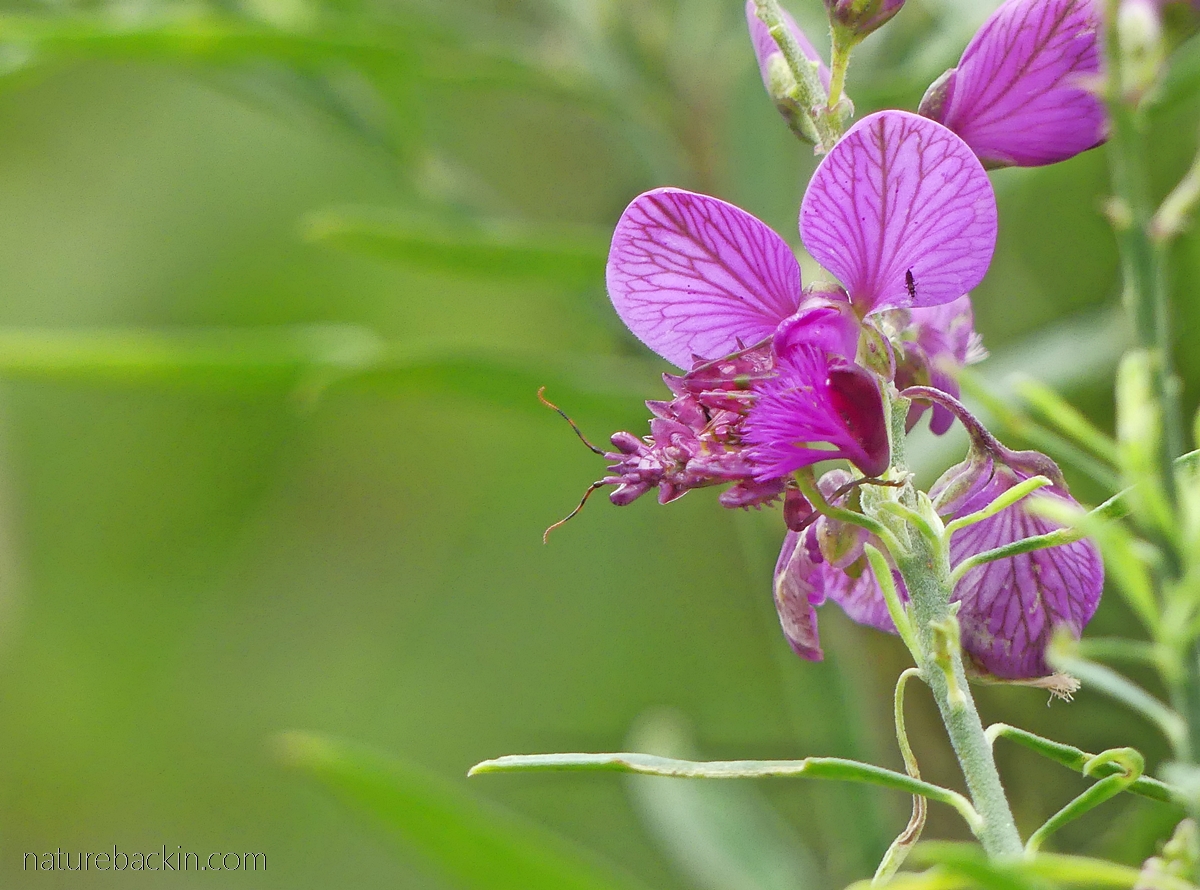
And to end, another photo of the mantid on the purple broom flowers, showing how well camouflaged it is. To a degree spiny flower mantids can adapt their colour to blend in with the flower or plant they spend the most time on. Some time back, our neighbour had a shrub known as a marmalade bush with orange flowers and a spiny flower mantis nymph hung out there and adapted its colour to a deep orange to blend in with the flowers.
I hope to be able to follow the further development of these intriguing little creatures, and perhaps I will be posting about them again. I have posted previously about seeing these mantids in the garden, see here and here.
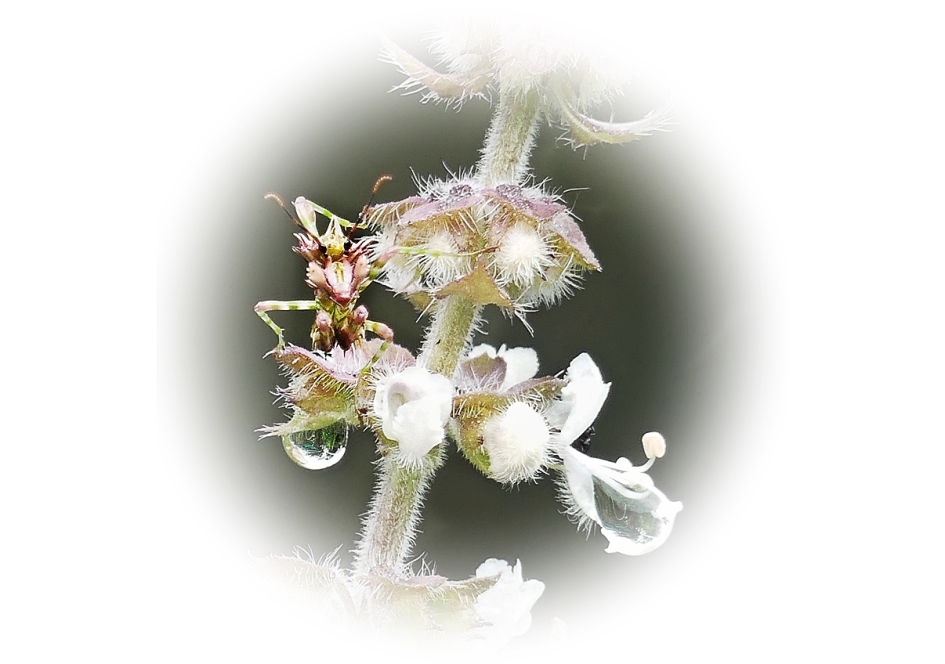
Sources:
Picker, Mike, Griffiths, Charles & Weaving, Alan. 2019. Field Guide to Insects of South Africa. Cape Town: Struik Nature; Wikipedia. 2021. Pseudocreobotra wahlbergii. https://en.wikipedia.org/wiki/Pseudocreobotra_wahlbergi
Posted by Carol

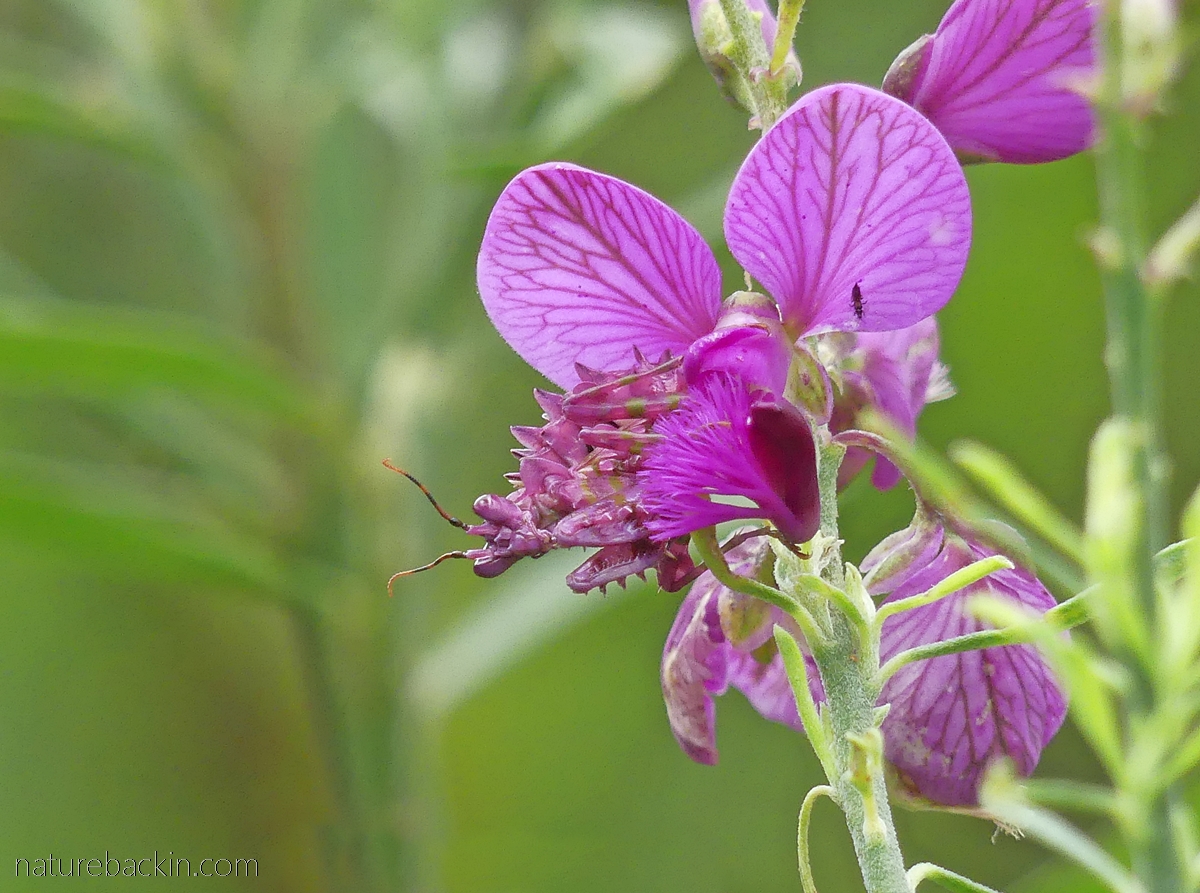




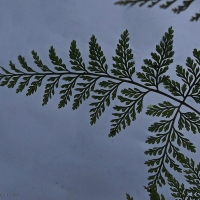
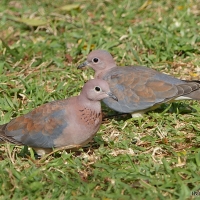
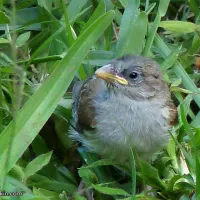
May 1, 2021 at 9:26 pm
Laughing- the photo shoot literally had me laughing out loud. I can just picture it!
But what follows is astounding…. you certainly have the patience of a saint to watch all this, much less capture it! I’m so glad I managed to get back here so that I didn’t miss this! What a pleasure to learn more about this planet’s interesting critters.
LikeLiked by 1 person
May 3, 2021 at 6:29 pm
Yes it was funny and so unexpected when the mantid climbed onto the matchbox!
The mantids are still around on the basil bush, but I find it hard to stay to watch when solitary bees and butterflies are nectaring at the bush as I rather dread any being caught, so I don’t linger that long!
LikeLike
April 19, 2021 at 1:23 pm
I found this examination of the spiny flower mantid nymphs fascinating, Carol. As this was an insect I have never heard of, at first I thought we were talking about that tiny insect on the right petal of the (first photo) flower. Then I started noticing what looked like antennae on what appeared to be the flower, but was the insect. Then I figured it out and was completely in awe at the unusual body parts of this amazing mantid nymph. Your photos were wonderful and demonstrated all the features. I so loved your creative matchbox photo shoot, and chuckled at your dry humor of cohabiting with chafer beetles. Wonderful to be part of your adventure discovering this insect and nymphs, with your neighbor and then in your own garden. Appreciated the links to previous posts with more great photos.
LikeLiked by 1 person
April 19, 2021 at 6:20 pm
It is interesting how the eye suddenly starts discerning the mantid and separating its complex shape from the camouflaging flower. Even now after watching them quite a bit when I go out to find them on the basil bush it can be challenging to pick them all out – there seem to be seven there currently. I am hoping to be able to watch their development over the next few weeks. Thanks so much for your interest and comment and also for visiting the previous posts about these remarkable little mantids.
LikeLiked by 1 person
April 18, 2021 at 10:24 am
Extraordinary creatures. Definitely wouldn’t want to meet one if I was a katydid, but from an ecologist’s perspective, they are certainly interesting.
LikeLiked by 1 person
April 18, 2021 at 8:56 pm
They are very interesting. From what I have seen the past few days they have been catching mostly flies and solitary bees, and several times I have seen two hunting each other, but as they get relatively close to each other, one or both just drop so as to escape. They then climb back up into the bush.
LikeLiked by 1 person
April 11, 2021 at 9:13 am
How brilliant that you have gone to such trouble to showcase these amazing little creatures that many of us might barely notice, if at all. They definitely merit closer examination – extraordinary!
LikeLiked by 1 person
April 12, 2021 at 6:39 pm
Thanks Margaret. They are extraordinary. To our eyes their ornate beauty is at odds with their unpleasant style of eating their prey live though!
LikeLiked by 1 person
April 12, 2021 at 8:25 pm
No manners, obviously!
LikeLiked by 1 person
April 10, 2021 at 10:47 am
Wow, Carol! I have never seen these mantids before, and think they are amazing! I can’t believe how small they are. Your photos of them are amazing!
LikeLiked by 1 person
April 12, 2021 at 6:31 pm
Thanks so much. They are incredibly tiny at first but they get slightly larger with each moult. I really hope to see at least one of them reach adulthood.
LikeLiked by 1 person
April 12, 2021 at 9:49 pm
Oh I hope you do get to see an adult! That would be amazing!
LikeLiked by 1 person
April 15, 2021 at 11:43 am
Here’s hoping …
LikeLiked by 1 person
April 10, 2021 at 10:32 am
Thank you for making us aware of this amazing creature with its extraordinary camouflage ability. I would have loved to see it orange as well!
LikeLiked by 1 person
April 12, 2021 at 6:29 pm
Thanks Christine. Unfortunately I did not get the opportunity to photograph the one in the orange flowers.
LikeLike
April 9, 2021 at 4:49 pm
Your pictures of the mantid nymphs are superb, Carol! 👏👏👏 I would love to see these insects live. I could photograph them for hours! Such interesting and beautiful creatures!!
LikeLiked by 1 person
April 10, 2021 at 9:25 am
Thanks for your kind comment Simone 🙂 You would love to spend time photographing and observing them. They are more engrossing to watch than the average TV programme!
LikeLiked by 1 person
April 10, 2021 at 12:11 pm
I am sure of it!
LikeLiked by 1 person
April 10, 2021 at 12:24 pm
Look, what I’ve found! 🙂 https://youtu.be/M0E3OoBi_4o
LikeLiked by 1 person
April 12, 2021 at 6:34 pm
Thanks for the link and it was interesting to see that. I have uncomfortable feelings about the pet trade in such creatures though …
LikeLiked by 1 person
April 12, 2021 at 8:42 pm
Yes, when you look at it that way, it’s true. You’re right about that. I saw first and foremost the tiny size, which is well illustrated by the hand.
LikeLiked by 1 person
April 15, 2021 at 11:43 am
The mantid nymphs do look beautiful and so tiny on the person’s hand, I do agree. The ones in our basil bush are surprisingly aggressive hunters and yesterday I even saw one hunting another mantid, but suddenly they both fell and then scrambled up separate parts of the bush. Mantids can be cannibalistic, which is a discouraging quality for anyone wanting to keep them captive! Plus of course their ever-present appetite for live prey …
LikeLike
April 9, 2021 at 10:23 am
How I love these magical little creatures, Carol you have so eloquently captured them, an absolute delight! xxx
LikeLiked by 2 people
April 10, 2021 at 9:22 am
Thank you Christeen. It is true, there is something almost magical about them, or at least slightly surreal xxx
LikeLiked by 1 person
April 9, 2021 at 9:40 am
Absolutely fascinating
LikeLiked by 1 person
April 10, 2021 at 9:21 am
They truly are. Thanks Mariss.
LikeLiked by 1 person
April 9, 2021 at 8:13 am
Fascinating creatures, and what a marvelous job you’ve done, as per usual, in showcasing them, Carol!
LikeLiked by 2 people
April 10, 2021 at 9:21 am
Thanks so much. They really are fascinating to watch, and so beautifully intricate too.
LikeLiked by 1 person
April 9, 2021 at 7:29 am
Yes I found those cratures very special and spent much time watching them until they suddenly dissapeared.
LikeLiked by 1 person
April 10, 2021 at 9:19 am
Funny how they suddenly disappear. I am hoping that I see at least one of the nymphs currently around develop into adulthood. I remember how exciting it was the first time you showed me the flower mantids in your garden!
LikeLike
April 9, 2021 at 4:37 am
What a sharp eye and huge dollops of patience you have, along with a steady hand! These photographs are a fascinating record of what goes on under our noses as it were. You had me totally absorbed by these fascinating creatures!
LikeLiked by 2 people
April 10, 2021 at 9:09 am
Thanks Anne. After a while one’s eye gets trained to spot them more easily. Absolutely, there is a lot going on that we are usually oblivious of. Even though the mantids are relatively stationery they are fascinating to watch nevertheless. Now that they are bigger and becoming more aggressive hunters watching them and their potential prey becomes a bit anxiety inducing!
LikeLiked by 1 person
April 9, 2021 at 4:17 am
Fabulous photos Carol. They’re such extraordinary creatures and you’ve captured them beautifully. Their behavior is fascinating and ability to blend in and strike is easy to see in the photos.
LikeLiked by 1 person
April 10, 2021 at 9:05 am
Thanks so much Graham. They are extraordinary and quite engrossing to observe. I hope that I will be able to see some of them reach adulthood.
LikeLiked by 1 person
April 10, 2021 at 4:36 pm
That would be very cool.
LikeLiked by 1 person
April 9, 2021 at 12:00 am
They are fantastical creatures, and so tiny. Kind of gruesome in their eating habits. 😉
Your photos are excellent, Carol!
LikeLiked by 1 person
April 10, 2021 at 9:00 am
Thanks very much Eliza. Yes their eating habits are very gruesome and quite hard to watch.
LikeLiked by 1 person
April 8, 2021 at 11:40 pm
Great shots, and impressive camouflage!!
LikeLiked by 1 person
April 10, 2021 at 8:59 am
Thanks very much – yes the amazingly ornate camouflage is very effective.
LikeLike